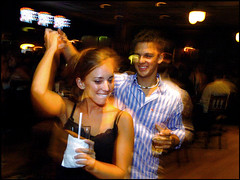Dan Wisdom and beyond
Dan of Danspotting is also the awesome photographer behind BeyondDC, and a strong proponent of urban design, placemaking, and transportation. Some stuff he's written lately, including comments on this blog, need to more widely communicated.
Here, he comments about the idea of the Third Century Mall, and continuing to centralize cultural experiences and assets in the Federal core:
A balance must be struck. On the one hand you need cross-promotion and proximity to generate users, but the ultimate goal (from a planning perspective that is) should always be enhancing urban diversity, and a single-use pod of cultural uses is every bit as urbanistically deadening as a single-use pod of any other land use. While it’s true that the more cultural uses you plop in one location the more efficiently that location handles them, it does so at the expense of urban diversity as that location becomes ever more isolated from the rest of the living city. On the other hand, if you use cultural nodes as civic components in mixed-use neighborhoods, you enhance the experience for all.
In other words, classic Jane Jacobs.
As for your library / city museum idea, I think it has real merit. Those are both uses that on their own are going to have trouble thriving in Washington, where we already have the best museums and biggest library in the world. They are naturally synergistic uses and a combined civic center in the heart of downtown could 1) have the critical mass to succeed where those projects individually would fail, and 2) act as a catalyst to bring visitors who would otherwise stick to the mall into the city.
Relating to his point about catalyzing experiences, in another venue where we both write, he had this to say:
As a bona fide member of Generation Y who grew up in the suburbs I can attest that urban form is just not on the minds of most of my peers. Friends from my suburban high school who are just now leaving college and entering the professional world do not consciously make the choice to live in the suburbs over the city. They just do. The fact that a choice even exists simply does not occur to most of them. If you press them about it they do not view the city badly. It's just so far removed from their reality that asking them why they don't live there is like asking why they don't live on the moon... and no amount of reduced crime statistics or higher gas prices is going to change that.
 Katherine Frey/The Washington Post. Danny Mitchell, 22, twirls Ashleigh Aucott, 21, in a corner of Kirkpatrick's in Ashburn.
Katherine Frey/The Washington Post. Danny Mitchell, 22, twirls Ashleigh Aucott, 21, in a corner of Kirkpatrick's in Ashburn.No, the only way to change their views is to bring the city to them. And that, in my opinion, is one of the chief values of greenfield TNDs and lifestyle centers. Even if they are less than fully urban, they introduce some measure of urbanity to people who would not experience it otherwise, which can only be a good thing.
My response was this:
Relating to Dan's excellent point (and chilling for an old urbanist like me), over the past few months both the Washington Post and the Baltimore Sun have been writing about this such as the Post article "Young, Restless and Finally Catered To: In Outer Suburbs, Nightlife Venues Find a Burgeoning Clientele Eager to Spend."
There have been more pieces than this article. We have to have very spiffed up places and market creatively and hard to get suburbanites to sample the city, especially when they are young. Especially given that tv shows these days aren't promoting urban life quite in the same way as Seinfeld and Friends, which were powerful promoters of City Living.
 Friends, a show where young adults moved into "The City" from the suburbs, was a powerful promoter of urban living.
Friends, a show where young adults moved into "The City" from the suburbs, was a powerful promoter of urban living.Related is something I wrote in June, from "You (Don't) really like me--DC and its suburbs:"
In the thread last year on H-DC about the closure of the City Museum, an instructor from George Mason, J.F. Saddler, wrote:
This semester in my U.S. history surveys at George Mason, I assigned my students to evaluate the (potential) effectiveness of the City Museum and the "Washington Perspectives" exhibit. I gave them a detailed list of questions that asked about, among other things, accessibility of the museum, how well the museum and exhibit held their attention, ease of "use", and clarity of the story being told. In the overall exercise, I instructed them to read the museum and its exhibit as they would a written text or an image that I had given them in class--another way of conveying history and meaning.
The summary of 125 students' answers to the four basic issues above were:
1) Accessibility: Many were put off not by the location, per se, however they were indeed apprehensive about the museum's general environment. Although they realized that the Museum is in a transitional area of the city, they were uncomfortable with what some described as the gauntlet of people asking for money as they entered the grounds of the museum. They related this as well to the level of refuse strewn around the building. In sum, many of my students--almost all of whom are Northern Virginia suburbanites--averred that they would not recommend out of town guests to visit the museum for this reason alone.
Comments like Dan's and Professor Saddler's can't be ignored. We "old urbanists" are doing market development for tcenter cities and for urbanism-urban design. And until we get another tv show like "Friends," we're going to have to work that much harder.
Index Keywords: urban-design, mixed-use, Jane-Jacobs, new-urbanism, new-(sub)urbanism



0 Comments:
Post a Comment
<< Home